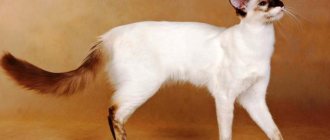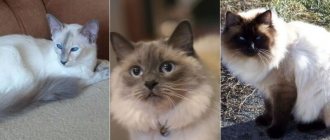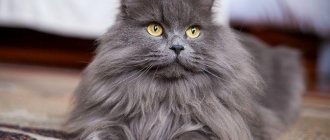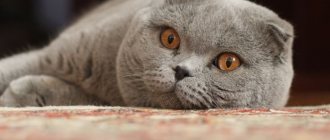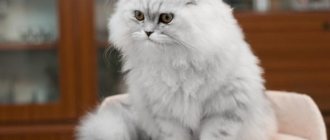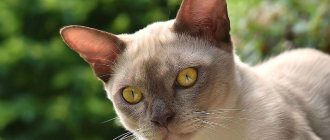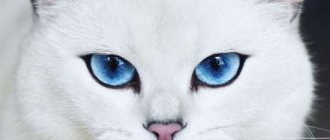Can a human shadow have a tail and four legs? Maybe if there is a Balinese cat in the house, which always follows on its owner’s heels. This graceful cat with expressive almond-shaped eyes moves as gracefully as a Balinese dancer. She loves to be the center of attention and does not tolerate loneliness well.
Balinese cat: description of the breed
Brief history of the breed
America is considered the birthplace of the Balinese. According to one version, they appeared as a result of a gene mutation. According to the second theory, Balineses were bred as a result of mating Angora and Siamese cats.
Serious work on creating a new breed began in 1950 on the initiative of Marion Dorset. Ten years later, Helen Smith joined her and suggested calling the resulting cats Balinese.
For a long time, the breed did not receive official recognition from the public. It was possible to register the Balinese only in 1970 thanks to the persistence and tenacity of the breeders.
Interesting Facts
Although Balinese cats appeared relatively recently, they managed to associate a lot of interesting things with the breed:
- The name of the animals has nothing to do with the area where they were bred. It is associated with the appearance of cats, which with their grace resemble Balinese dancers.
- The color of the coat of representatives of this breed is influenced by a special gene, the activity of which changes with cold weather. Therefore, it is better to keep Balinese dogs in warm rooms with an air temperature of 22-24 °C.
- Kittens of this breed are born with short hair. The guard hair lengthens as the Balinese matures.
Colors
There are two dozen existing colors, but major European felinological organizations recognize only 4:
- Blue point: paw pads and nose are gray, points are gray-blue, the main tone is also gray-blue, but of a cooler shade;
- Lilac point (frost point): the body and paws are painted snow-white, but here and there there are stripes and spots of ivory color;
- Shade of chocolate: the main color is “baked milk”, o;
- Seal point: the main color is light beige, with gray or dark brown markings on the tail, paws and face.
In the photo there are cats of the Balinese breed, popular colors.
Some other associations (including American ones) recognize several more colors:
- Torti: a mixture of dark and red;
- Cream: warm shade of light cream;
- Tabby: stripes on body and limbs;
- Ed: red marks.
Kittens are born with light fur, without spots or stripes, and as they grow older the color becomes more typical. Uniformity of color is the main requirement of judges at exhibitions. The entire muzzle should be covered by a mask, but there should not be one in the upper part of the head.
Expert opinion
Dusheba Vera Ivanovna
In 2010, she graduated from the Moscow State Academy of Veterinary Medicine named after K.I. Scriabin with honors, specializing in veterinary medicine. I regularly attend veterinary conferences, congresses, and webinars.
This breed is considered one of the most hypoallergenic: the amount of protein in their saliva is minimal, which means that allergy sufferers can own these animals without fear.
Breed description, standards, appearance
The Balinese cat has a graceful, athletic build and well-developed muscles. Visually, it is very similar to the Siamese, only with longer hair. The first breed standard appeared in 1967. It regulates not only the exterior, but also the behavioral characteristics of the Balinese.
Dimensions and weight
Representatives of the Balinese breed are not large animals. Females weigh on average 3.5 kg. Cats of this breed are heavier: the body weight of an adult male is about 5 kg.
Anatomical characteristics
Pedigree Balinese cats must meet the following description:
- The head is small, wedge-shaped with a narrowed, elongated muzzle, straight profile, pointed chin, high prominent cheekbones and a strong lower jaw.
- The eyes are almond-shaped, expressive, and slanted. The color of the iris is blue or blue.
- The ears are triangular, erect, disproportionately large. They have rounded tips and are a harmonious continuation of the wedge-shaped head.
- The body is stretched, slender with well-developed muscles.
- The limbs are thin, long with small oval paws. The front ones are slightly shorter than the rear ones.
- The tail is thin and long. Visually resembles a whip. Decorated with plumes.
Color and coat type
The body of a Balinese cat is covered with shiny, silky hair. On the chin, tail and neck of the animal, the hair is slightly wavy.
The colors of the Balinese can be varied. The most common colors found in the breed are:
- frost point;
- brown (chocolate) point;
- seal point;
- blue point;
- tabby
On a note. Balinese kittens are born with a uniform coat. The formation of color is completed by 12-18 months.
Possible breed defects
The disadvantages of the exterior of Balinese cats include:
- strabismus;
- kinks on the tail;
- dark spots on the stomach;
- white fingers;
- lack of markings on paws and muzzle;
- solid black or red color.
Balinese dogs with at least one of the above defects are not allowed for exhibitions and are not used for breeding.
Choosing a Balinese kitten and cost
When choosing a pet, you should remember that the Balinese beauty is a blue-eyed cat with a long body, large ears and a long nose. It is similar to the Siamese, but its peculiarity is medium-length hair without a hint of undercoat.
At birth, the Balinese is white. To make sure that a kitten is purebred, you need to see its parents with pedigrees.
It is allowed to breed a Balinese cat only with Siamese, Seychelles and long-haired Orientals. The kitten must have a pedigree and a veterinary record with vaccinations.
What does a Balinese kitten look like?
When buying a Balinese, you need to be extremely careful. They are often given away as long-haired kittens of various origins with a “Siamese” color.
A purebred kitten will not be cheap, from 350 USD. by advance reservation. If the animal does not participate in exhibitions and breeding, then you can buy a pet-class cat. This is the same purebred pet without defects, but it is easier to acquire and will cost much less.
Character and temperament
Balinese cats are sociable, curious and intelligent creatures. Thanks to their natural flexibility and acrobatic abilities, they can easily climb tall cabinets and other hard-to-reach places in search of interesting objects.
Balinese cats need constant communication with people and love to be the center of attention. They quickly become attached to their owners and do not tolerate loneliness well.
Balinese cats are not as violent and selfish as their Siamese relatives. By temperament type, representatives of this breed are true sanguines.
Balinese are energetic, active animals that never get discouraged.
Breed and children
The Balinese cat gets along well with the owner's kids. Especially if children understand how to properly communicate with a pet and do not offend it.
He will be happy to play with them. But if the kids start squeezing the Balinese or carrying it in their arms, the cat may show its claws.
Breed and other animals
Balinese cats have always lived close to people and never foraged for food in their natural environment. Therefore, they do not have developed hunting instincts and are calm towards other animals.
Balinese cats get along well with a variety of pets, from dogs to rodents.
Positive and negative points
Every year Balinese cats become more and more popular. Cute, playful and loyal, they are a favorite for single people and families with children.
Positive aspects of this cat:
- grace and grace;
- calm character;
- love for people;
- lack of aggressive attitude towards children;
- ability to educate and train;
- intelligence and intelligence;
- cleanliness;
- unpretentiousness.
Before buying a cat of this breed, you need to consider the following:
- The Balinese cat cannot stand being alone. She should not be left alone for a long time. Therefore, it is better not to get such a cat for people who are often away from home for a long time.
- Balinese does not tolerate aggression and quarrels. In such cases, it often changes its character and becomes similar to its owner.
- Pets meow often and loudly.
How to choose the right kitten
Balinese cats are a fairly rare breed. Therefore, it is better to buy such an animal in a specialized nursery or from a professional breeder with a good reputation. Before purchasing a small Balinese, you need to read the documents and look at the conditions of its maintenance.
A healthy kitten is large, active and very mobile. He shows no fear and is interested in everything that happens around him. The little Balinese has a soft belly, clear, non-squinting eyes, pink gums, an even tail without knots or creases, clean skin and fresh breath.
Kitten care
A small Balinese requires more attention than an adult animal. Usually he gets into a new home no earlier than 3 months of age and by this time he is already accustomed to the tray and scratching post.
To make caring for your pet easier, before his arrival, purchase:
- bowls for food and water;
- bed or house;
- tray and filler;
- scratching post;
- carrying bag;
- toys;
- cosmetics (shampoo, toothpaste, etc.).
To prevent the tailed pet from causing trouble in the future, it is immediately taught the rules of behavior in the house and hygiene procedures.
Care and maintenance
Representatives of the Balinese cat breed do not have an undercoat, which provides reliable protection from the cold. Therefore, they are completely unsuited for life on the street and are suitable exclusively for indoor keeping.
Caring for Balinese cats is not particularly difficult and comes down to proper feeding and hygiene.
Hygiene procedures
In order for the Balinese cat to look aesthetically pleasing, it is provided with appropriate care:
- The animal's eyes and ears are regularly wiped with a moistened cotton pad and inspected for unusual discharge. If balinese pus is detected, be sure to show it to a veterinarian.
- To prevent plaque and tartar from forming on your cat’s teeth, they are cleaned weekly with a silicone brush and a special paste that does not foam.
- Although Balinese dogs grind their nails down on their own, they are trimmed regularly to keep them looking well-groomed.
Grooming
To prevent the Balinese cat's fur from becoming tangled, it is combed several times a week with a special comb. During molting, the procedure is carried out more often than usual in order to speed up the loss of dead hair and the growth of new integument.
Since Balinese cats take care of the cleanliness of their coats on their own, they do not need frequent washing. Cats of this breed are bathed 2-3 times a year. The procedure is carried out in a warm room, away from drafts.
The wetted Balinese wool is lathered with a special shampoo and then rinsed with non-hot water. The bathed cat is thoroughly dried with a towel.
On a note. A hairdryer can dry out the silky Balinese coat. Therefore, it is better to refuse its use.
Tray
Balinese cats are not large animals, so both open and closed trays are equally suitable for them. But the choice of filler must be taken with special responsibility.
It must be of high quality and have good absorbent properties. Low-quality mineral or wood fillers are not suitable for long-haired Balinese. Such granules quickly become soaked and turn into an incomprehensible substance that sticks to the cat’s tail and paws and spreads throughout the house.
Education and training
The high level of intelligence inherent in the breed greatly simplifies the process of training its representatives. Balinese dogs quickly socialize, easily adapting to changing living conditions, and are excellent at learning new material. Experienced breeders recommend talking to the kitten as much as possible, explaining any actions - this approach works much better than dry commands. By the way, about commands: Balinese are so smart that they are able to recognize the meaning of more complex calls than the banal “kitty-kitty”. For example, almost all pets know their own names and respond to them. Moreover, some cat owners agree to remember up to three different nicknames and respond to each, which is considered an almost unique phenomenon.
Balinese cats are pliable and readily absorb information presented by their owner. They make it easy to learn funny tricks and play sports. In particular, the breed demonstrates good results in cat agility, which it perceives as a fun game. So if you come across a pet with a defect that does not allow you to compete at breed shows, such competitions will be an excellent alternative to performing in the ring, because not only purebred and show pets, but also any healthy cat can participate in them.
Balinese are excellent psychologists who masterfully read the owner’s emotions, so their habits are easier to correct. For example, cats quickly get used to all sorts of restrictions and try to follow them as best they can. For the same reason, there is no point in applying serious punishments to Balinese fluffies. It is better to take a four-legged hooligan to scare him. The cat climbed onto the table - sneak around the corner and spray it with water from a flower sprayer. Balinese has gotten into the habit of sharpening his claws on your favorite chair - treat the fabric with lemon or orange essential oil so that the smell disgusts your pet.
When instilling behavioral norms in your kitten, always remember about the character traits and habits of the breed. For example, if your pet toilets in a place not intended for this, do not punish him, but first check the litter box. Balinese cats are perfectionists when it comes to cleanliness and will not relieve themselves a second time in stale litter. It is pointless to scold this animal and try to retrain it, so either clean the tray after each such “trip”, or give up your dream of owning a Balinese.
Feeding the cat
Not only its health, but also its appearance depends on the quality of the Balinese’s diet. In order for the cat to develop properly and have beautiful fur, it is provided with a balanced menu.
Complete diet
It is most convenient to give your Balinese cat premium or super premium industrial food. It contains all the vitamins and microelements necessary for the normal development of the pet.
The main thing is that it does not contain dubious additives such as soy, dyes or flavor enhancers. These requirements best meet:
- Royal Canin;
- Acana;
- Pronature.
When feeding a Balinese cat with natural products, the diet is designed so that different types of meat predominate in it. The animal is also given:
- porridge;
- vegetables;
- eggs;
- dairy products.
It is strictly forbidden to treat Balinese with sweets, river fish and leftovers from the master's table.
Important! Contrary to popular belief, an adult Balinese cat should not be given fresh milk. It can cause indigestion in the animal.
Feeding frequency
A kitten of this breed eats little by little, but often. Therefore, the frequency of meals depends on the age of the balinese:
- up to 6 months – 4 times a day;
- 6-12 months – 3 times a day;
- over 12 months – 2 times a day.
Vitamins and minerals
It is advisable to give a Balinese cat that eats natural food additional vitamins twice a year. The use of such complexes helps to activate hair growth, improve skin condition and strengthen the animal’s bones.
They are selected taking into account the individual needs of a particular balinese and given in dosages recommended by the veterinarian.
Best suited for Balinese cats:
- 8 in 1 Excel Brewer's Yeast;
- Beaphar Kitty's Mix;
- Canina Canivita;
- Polidex Immunity up.
Nutrition
The Balinese cat is not capricious when it comes to food, but a balanced diet is the key to the health of your furry pet. The menu should be varied and healthy.
The following products are used for preparation:
- different types of raw lean meat (necessarily well frozen);
- fresh heart;
- liver;
- egg yolks;
- kelp;
- fish fat;
- plantain seeds;
- vitamins B and E;
- water.
Cooked food is placed in containers and put into the freezer. When defrosting, do not use a microwave oven. The food is heated in a cup of warm water. For constipation, you can add pureed vegetables to your diet.
It is important that your cat always has fresh water.
Health and susceptibility to disease
Balinese cats are strong animals with good immunity. With proper care, representatives of the breed live 15-20 years and remain active for a long time. But, like any other cats, Balinese cats are prone to certain health problems.
Most often found in the breed:
- bronchial asthma;
- dysplasia of the elbow and hip joints;
- diabetes;
- gingivitis;
- amyloidosis of the kidneys and liver.
Diseases
This breed is in good health - alas! – can’t boast. The most common ailments:
- Strabismus (this problem can be obvious or smoothed out, but one thing is known: you cannot get rid of it);
- Cutaneous asthenia is a pathology in which the skin becomes so thin that it is injured even with normal movement;
- Asthma - it is caused by some allergen;
- Esophageal achalasia – the esophagus increases in size, causing the cat to belch, vomit, and have abdominal pain;
- A defect of the heart muscle is detected in kittens. There is no treatment;
- Amyloidosis of the liver and kidneys is a common disorder. The disease cannot be cured, but supportive therapy and diet can significantly prolong the life of a pet.
In addition, Balinese cats are more prone to cancer than others: lung cancer, mammary cancer. Elderly people often suffer from diabetes.
Puberty in males occurs at 9-10 months, in females sometimes earlier. However, you should not “breed” animals under one and a half years old. Give them time to gain strength. Keep in mind: during the rutting period, the cat becomes not herself: she can roll on the floor, scream, tear up walls and throw herself at doors.
If you do not plan to breed, consult a veterinarian and he will tell you what operation should be performed in your case. But various kinds of drugs - both drops and tablets - do not work well.
Vaccinations and antiparasitic treatments
To protect the Balinese cat from viral and infectious diseases, it is regularly vaccinated. To do this, a complex drug is introduced into the pet’s body to provide protection:
- from rhinotracheitis;
- viral leukemia;
- calcivirosis;
- panleukopenia;
- rabies.
The first vaccination of the Balinese is carried out at the age of 8 weeks, and the further schedule is agreed upon with the veterinarian. Vaccination is given only to completely healthy animals that have undergone preliminary antiparasitic treatment.
The Balinese cat is protected from fleas using a collar, drops or shampoos. They are used strictly according to the instructions on the packaging.
To get rid of internal parasites, the Balinese cat is given anthelmintic drugs every 3-4 months, repeated every 10-12 days.
Pros and cons of the breed
Like any other cat, Balinese cats have both positive and negative traits.
| Advantages | Flaws |
| Easy to care for | Poor tolerance of loneliness |
| Cleanliness | Tendency to certain health problems |
| Kindness and sociability | Excessive mobility |
Balinese cats are attractive animals with a cheerful, easy-going character. Beautiful appearance, sociability and cleanliness make the breed an ideal option for people thinking about buying a furry pet.
